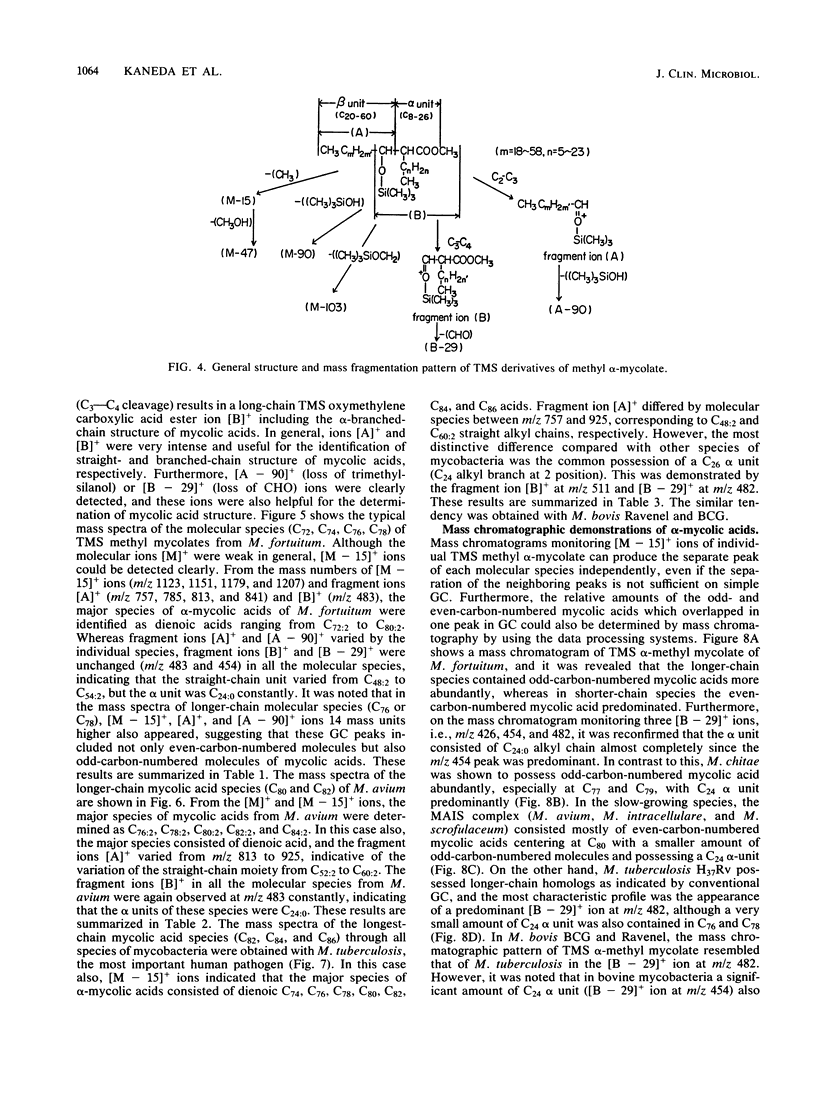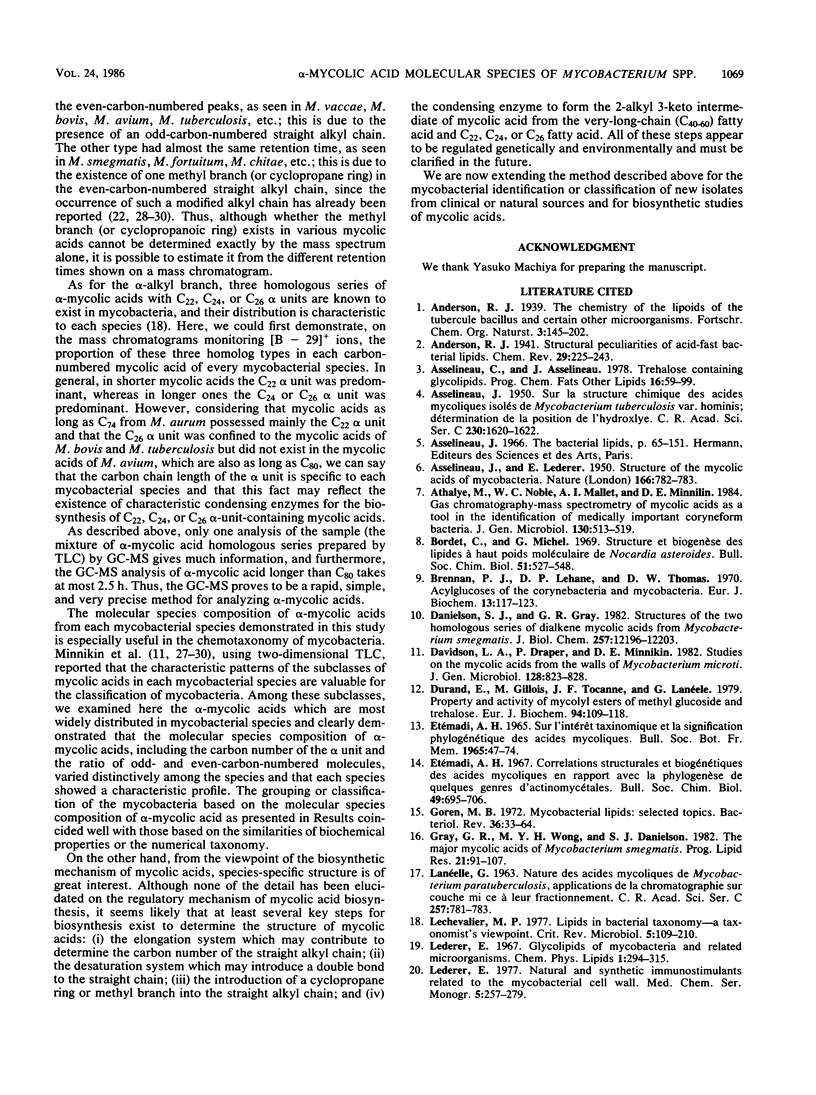Abstract
The molecular species composition of alpha-mycolic acids ranging from C68 to C86 in 13 rapidly growing and 12 slowly growing mycobacterial species was determined by gas chromatography, gas chromatography-mass spectrometry, and mass chromatography. In gas chromatographic analysis, the molecular species of alpha-mycolic acids were well separated as trimethylsilyl ether derivatives of the methyl esters, according to their total carbon numbers. The total carbon and double-bond numbers of mycolic acids at each peak on gas chromatograms were determined from the [M]+, [M - 15]+, and [M - 90]+ ions on the mass spectrum, and straight and branched chain structures were identified by the mass fragment ions [A]+, due to C2--C3 cleavage [R-CH-O-Si(CH3)3]+, and [B]+, due to C3--C4 cleavage [(CH3)3-Si-O-CH-CH(R')-COOCH3]+. The concentration of odd- and even-carbon-numbered mycolic acids, which often overlap each other on gas chromatograms, and the composition of three homologous mycolic acids with different alpha units (C22:0, C24:0, and C26:0) were clearly determined by mass chromatography monitoring [M - 15]+ ions and [B - 29]+ ions, respectively. The molecular species composition of alpha-mycolic acids and their average carbon numbers (av. cn.) as a simple expression of the composition were calculated from the mass chromatograms. Each mycobacterial species examined was demonstrated to possess a characteristic profile of alpha-mycolic acid composition, and based on this the species were classified approximately into eight groups: C68 to C76 (av. cn. 72), dienoic, possessing a C20 alkyl branch at the 2 position (C22 alpha-unit) for Mycobacterium diernhoferi and Mycobacterium sp. strain 3707, a chromogenic rapid grower; C72 to C78 (av. cn. 75), dienoic with both C22 and C24 alpha units, containing a small or a large amount of odd-carbon-numbered molecules, for M. vaccae, M. rhodesiae, and M. phlei (chromogenic rapid growers); C72 to C80 (av. cn. 75 to 77), dienoic with C24 alpha-unit, containing a moderate or a large amount of odd-carbon-numbered molecules, for M. smegmatis, M. chitae, M. chelonae (M. chelonei), and M. fortuitum (nonchromogenic rapid growers); C78 to C82 (av. cn. 80), even-carbon-numbered dienoic with C24 alpha unit for M. agri and M. thermoresistible (rapid growers); C75 to C81 (av. cn. 77 to 79), odd-carbon-numbered dienoic with C24 alpha unit for M. nonchromogenicum complex (M. nonchromogenicum, M. terrae, and "M. novum") (slow growers); (vi) C76 to C84 (av. cn. 79 to 81), even-carbon-numbered dienoic with C24 alpha unit for MAIS complex including M. scrofulaceum, M. avium, and M. intracellulare (slow growers); (vii) C72 to C80 (av. cn. 77 to 79), even-carbon-numbered dienoic with C24 alpha unit for M. szulgai, M. gordonae, and M. kansasii (chromogenic slow growers); and (viii) C76 to C86 (av. cn. 79 to 81), even-carbon-numbered dienoic with C26 alpha unit M. bovis Ravenol and BCG and M. tuberculosis H37Rv. This study demonstrated that gas chromatography-mass spectrometric analysis of the molecular species composition of alpha-mycolic acid can give rapid, important, and very precise information for the identification of pathogenic and nonpathogenic mycobacterial species.
Full text
PDF










Images in this article
Selected References
These references are in PubMed. This may not be the complete list of references from this article.
- ASSELINEAU J., LEDERER E. Structure of the mycolic acids of Mycobacteria. Nature. 1950 Nov 4;166(4227):782–783. doi: 10.1038/166782a0. [DOI] [PubMed] [Google Scholar]
- Asselineau C., Asselineau J. Trehalose-containing glycolipids. Prog Chem Fats Other Lipids. 1978;16:59–99. doi: 10.1016/0079-6832(78)90037-x. [DOI] [PubMed] [Google Scholar]
- Athalye M., Noble W. C., Mallet A. I., Minnikin D. E. Gas chromatography-mass spectrometry of mycolic acids as a tool in the identification of medically important coryneform bacteria. J Gen Microbiol. 1984 Mar;130(3):513–519. doi: 10.1099/00221287-130-3-513. [DOI] [PubMed] [Google Scholar]
- Bordet C., Michel G. Structure et biogenèse des lipides a haut poids moléculaire de Nocardia asteroides. Bull Soc Chim Biol (Paris) 1969 Jul 25;51(3):527–548. [PubMed] [Google Scholar]
- Brennan P. J., Lehane D. P., Thomas D. W. Acylglucoses of the corynebacteria and mycobacteria. Eur J Biochem. 1970 Mar 1;13(1):117–123. doi: 10.1111/j.1432-1033.1970.tb00906.x. [DOI] [PubMed] [Google Scholar]
- CHESTER S. T., BELL H. G. The management of the duodenal stump in gastric resection for technically difficult duodenal ulcer. West J Surg Obstet Gynecol. 1955 Nov;63(11):701–705. [PubMed] [Google Scholar]
- Danielson S. J., Gray G. R. Structures of the two homologous series of dialkene mycolic acids from Mycobacterium smegmatis. J Biol Chem. 1982 Oct 25;257(20):12196–12203. [PubMed] [Google Scholar]
- Davidson L. A., Draper P., Minnikin D. E. Studies on the mycolic acids from the walls of Mycobacterium microti. J Gen Microbiol. 1982 Apr;128(4):823–828. doi: 10.1099/00221287-128-4-823. [DOI] [PubMed] [Google Scholar]
- Durand E., Gillois M., Tocanne J. F., Laneelle G. Property and activity of mycoloyl esters of methyl glucoside and trehalose. Effect on mitochondrial oxidative phosphorylation related to organization of suspensions and to acyl-chain structures. Eur J Biochem. 1979 Feb 15;94(1):109–118. doi: 10.1111/j.1432-1033.1979.tb12877.x. [DOI] [PubMed] [Google Scholar]
- Etemadi A. H. Corrélations structurales et biogénétiques des acides mycoliques en rapport avec la phylogenèse de quelques genres d'Actinomycétales. Bull Soc Chim Biol (Paris) 1967;49(6):695–706. [PubMed] [Google Scholar]
- Goren M. B. Mycobacterial lipids: selected topics. Bacteriol Rev. 1972 Mar;36(1):33–64. doi: 10.1128/br.36.1.33-64.1972. [DOI] [PMC free article] [PubMed] [Google Scholar]
- Gray G. R., Wong M. Y., Danielson S. J. The major mycolic acids of Mycobacterium smegmatis. Prog Lipid Res. 1982;21(2):91–107. doi: 10.1016/0163-7827(82)90001-7. [DOI] [PubMed] [Google Scholar]
- LANEELLE G. [Nature of mycolic acids from Mycobacterium paratuberculosis; application of thin layer chromatography to their fractionation]. C R Hebd Seances Acad Sci. 1963 Jul 17;257:781–783. [PubMed] [Google Scholar]
- Lechevalier M. P. Lipids in bacterial taxonomy - a taxonomist's view. CRC Crit Rev Microbiol. 1977;5(2):109–210. doi: 10.3109/10408417709102311. [DOI] [PubMed] [Google Scholar]
- Lederer E., Adam A., Ciorbaru R., Petit J. F., Wietzerbin J. Cell walls of Mycobacteria and related organisms; chemistry and immunostimulant properties. Mol Cell Biochem. 1975 May 30;7(2):87–104. doi: 10.1007/BF01792076. [DOI] [PubMed] [Google Scholar]
- Lévy-Frébault V., Daffé M., Goh K. S., Lanéelle M. A., Asselineau C., David H. L. Identification of Mycobacterium fortuitum and Mycobacterium chelonei. J Clin Microbiol. 1983 May;17(5):744–752. doi: 10.1128/jcm.17.5.744-752.1983. [DOI] [PMC free article] [PubMed] [Google Scholar]
- Minnikin D. E., Alshamaony L., Goodfellow M. Differentiation of Mycobacterium, Nocardia, and related taxa by thin-layer chromatographic analysis of whole-organism methanolysates. J Gen Microbiol. 1975 May;88(1):200–204. doi: 10.1099/00221287-88-1-200. [DOI] [PubMed] [Google Scholar]
- Minnikin D. E., Goodfellow M. Lipid composition in the classification and identification of acid-fast bacteria. Soc Appl Bacteriol Symp Ser. 1980;8:189–256. [PubMed] [Google Scholar]
- Minnikin D. E., Minnikin S. M., Goodfellow M., Stanford J. L. The mycolic acids of Mycobacterium chelonei. J Gen Microbiol. 1982 Apr;128(4):817–822. doi: 10.1099/00221287-128-4-817. [DOI] [PubMed] [Google Scholar]
- Minnikin D. E., Minnikin S. M., Hutchinson I. G., Goodfellow M., Grange J. M. Mycolic acid patterns of representative strains of Mycobacterium fortuitum, 'Myobacterium peregrinum' and Mycobacterium smegmatis. J Gen Microbiol. 1984 Feb;130(2):363–367. doi: 10.1099/00221287-130-2-363. [DOI] [PubMed] [Google Scholar]
- Minnikin D. E., Minnikin S. M., Parlett J. H., Goodfellow M., Magnusson M. Mycolic acid patterns of some species of Mycobacterium. Arch Microbiol. 1984 Oct;139(2-3):225–231. doi: 10.1007/BF00402005. [DOI] [PubMed] [Google Scholar]
- NOLL H., BLOCH H., ASSELINEAU J., LEDERER E. The chemical structure of the cord factor of Mycobacterium tuberculosis. Biochim Biophys Acta. 1956 May;20(2):299–309. doi: 10.1016/0006-3002(56)90289-x. [DOI] [PubMed] [Google Scholar]
- NOLL H. The chemistry of cord factor, a toxic glycolipid of M. tuberculosis. Bibl Tuberc. 1956;(10):149–183. [PubMed] [Google Scholar]
- Qureshi N., Takayama K., Jordi H. C., Schnoes H. K. Characterization of the purified components of a new homologous series of alpha-mycolic acids from Mycobacterium tuberculosis H37Ra. J Biol Chem. 1978 Aug 10;253(15):5411–5417. [PubMed] [Google Scholar]
- Steck P. A., Schwartz B. A., Rosendahl M. S., Gray G. R. Mycolic acids. A reinvestigation. J Biol Chem. 1978 Aug 25;253(16):5625–5629. [PubMed] [Google Scholar]
- Tomiyasu I. Mycolic acid composition and thermally adaptative changes in Nocardia asteroides. J Bacteriol. 1982 Aug;151(2):828–837. doi: 10.1128/jb.151.2.828-837.1982. [DOI] [PMC free article] [PubMed] [Google Scholar]
- Tomiyasu I., Yano I. Separation and analysis of novel polyunsaturated mycolic acids from a psychrophilic, acid-fast bacterium, Gordona aurantiaca. Eur J Biochem. 1984 Feb 15;139(1):173–180. doi: 10.1111/j.1432-1033.1984.tb07991.x. [DOI] [PubMed] [Google Scholar]
- Toriyama S., Yano I., Masui M., Kusunose E., Kusunose M., Akimori N. Regulation of cell wall mycolic acid biosynthesis in acid-fast bacteria. I. Temperature-induced changes in mycolic acid molecular species and related compounds in Mycobacterium phlei. J Biochem. 1980 Jul;88(1):211–221. [PubMed] [Google Scholar]
- Toriyama S., Yano I., Masui M., Kusunose M., Kusunose E. Separation of C50--60 and C70--80 mycolic acid molecular species and their changes by growth temperatures in Mycobacterium phlei. FEBS Lett. 1978 Nov 1;95(1):111–115. doi: 10.1016/0014-5793(78)80063-5. [DOI] [PubMed] [Google Scholar]
- Wong M. Y., Gray G. R. Structures of the homologous series of monoalkene mycolic acids from Mycobacterium smegmatis. J Biol Chem. 1979 Jul 10;254(13):5741–5744. [PubMed] [Google Scholar]
- Wong M. Y., Steck P. A., Gray G. R. The major mycolic acids of Mycobacterium smegmatis. Characterization of their homologous series. J Biol Chem. 1979 Jul 10;254(13):5734–5740. [PubMed] [Google Scholar]
- Yano I., Kageyama K., Ohno Y., Masui M., Kusunose E., Kusunose M., Akimori N. Separation and analysis of molecular species of mycolic acids in Nocardia and related taxa by gas chromatography mass spectrometry. Biomed Mass Spectrom. 1978 Jan;5(1):14–24. doi: 10.1002/bms.1200050104. [DOI] [PubMed] [Google Scholar]
- Yano I., Saito K., Furukawa Y., Kusunose M. Structural analysis of molecular species of nocardomycolic acids from Nocardia erythropolis by the combined system of gas chromatography and mass spectrometry. FEBS Lett. 1972 Mar 15;21(2):215–219. doi: 10.1016/0014-5793(72)80140-6. [DOI] [PubMed] [Google Scholar]
- Yano I., Saito K. Gas chromatographic and mass spectrometric analysis of molecular species of corynomycolic acids from Corynebacterium ulcerans. FEBS Lett. 1972 Jul 1;23(3):352–356. doi: 10.1016/0014-5793(72)80314-4. [DOI] [PubMed] [Google Scholar]



